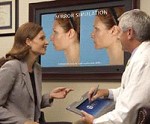
While digital imaging is a great asset to patient communication and understanding, it is also fraught on the flip side to ‘misrepresenting’ what can be done surgically or to expect that the result on one’s face or body can closely match these predictions. I routinuely point out to patients that these tools are for predictions and will likely not precisely match the outcome. I am well aware, however, that such commentary often falls on deaf ears. And in today’s world with nearly everyone having access to a digital camera, one’s postoperatuve results can be jjust as easily critiqued by patients as what we do as plastic surgeons with our own photos.
Therefore, several points about predictive imaging bear repeating. First and foremost, predictive imaging is similar to actual surgery in one important aspect…the manipulations are done by the surgeon’s hand. The only computer component of it is the fact that it is done on a computer screen with software. The outcome of both is still dependent on the surgeon’s hands and eye. No software program can guess what a surgical procedure will actually do or how one’s face or body will respond to surgical intervention. Computer imaging is precisely predictable, actual surgery is not. Secondly, predictive imaging is not intended to act as a benchmark to determine how successful the surgical procedure was. It is an estimate of what may happen, not a guarantee of what will happen.There will always be some differences between the predictions and the actual result. Thirdly, the purpose of predictive imaging is to relay a general concept of what can be done, to estimate whether the discussed procedures can create the general effect that the patient wants. They are not meant to be measured and analysed at the millimeter level. ‘Putting a ruler to it’ so to speak is to misinterpret why predictive imaging is being done.
Every patient that receives predictive imaging for their upcoming plastic surgery should be aware of these issues.
Dr Barry Eppley
Indianapolis, Indiana


